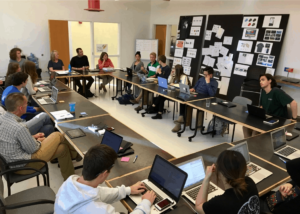Getting Through: Distributive Leadership

[vc_row][vc_column][vc_column_text]By: Rebecca Midles and Kelly Niccolls
Leading change is challenging for any organization. But in education, it is different from other professional fields where one’s ability to adapt is the key to survival. Effective educational leadership hasn’t always been about innovating and prototyping ideas to transform existing systems and structures. It certainly is now.
COVID-19, similar to the impact of 9/11, has changed us as a society. It has exposed a flawed design and thrown us into a reactive state. As the dust is starting to clear, we have opportunities to design (and re-design) learning and leadership for all. We have a chance to keep equity and learner voice at the center and to embrace newfound agility in responsive learning structures.
And initially, when these structures change, it mostly impacts adults in the process, which requires dynamic and responsive leadership. Principals and superintendents know they cannot lead this work alone. Successful systems practice distributed leadership. Sometimes this level of change for an organization can best be accomplished by a relatively ‘flat’ team in terms of roles, which allows for adaptability and increased responsiveness, as well as time for forward planning. One of the ways this can be structured is through distributed leadership.
Distributed leadership is a counter-narrative to traditional, isolated, expertise-focused leadership models. It resolves in community and requires collaboration and multiple stakeholders. As we navigate through COVID-19, many traditional leaders are struggling with highly nuanced and complex expectations and needs. Many times they resort to controlling details and final decision making to “make progress” with the intention of easing difficult situations. However, it is precisely in times like this that we need to shift to distributive leadership approaches, as Chris Sturgis details:
“Decision-making forms bottlenecks as problems are identified and move up and down the hierarchical ladder. Furthermore, the superintendent or principal is unlikely going to have a grip on all the information they will need to make a wise decision. They are going to need to bring in multiple perspectives and involve others in thinking through the chain reaction of changing any one piece of the system. Thus, even though distributed decision-making may appear to take longer, it is likely to make better and, in the long-run, faster decisions.”
Leading Fluid Space
Distributed leadership is not just creative with roles and teaming. It is also inclusive of leading over time in a more fluid way, thinking about how to hold time; in the present, for the future, and learning from the past. This style of educational leadership is not contained to superintendents but is also used by site leaders, department leaders, and teacher leadership. It does not mean that all leaders are doing the same thing, or in the same way, the work itself is distributed.
One integral strategy for effective change leadership is being intentional in creating time and space for distributive work that is time-sensitive, assigning people to think and do with an eye towards the future as well as utilizing the best people and resources to persist in the present. For example, a superintendent might not have the headspace or physical time to engage in future planning work right now, but there are people on the superintendent’s team that can, and should so that when the superintendent is able to focus on the future, they can enter into a well-framed plan that they can finalize and lead.
Inviting In And Listening To, All Stakeholders
When considering stakeholders that are part of collective leadership actions, it is important that leaders consider all the possible stakeholders. Parents, community leaders, students, and business partners are all integral participants in the work of education, and they should be represented in decision-making processes. When distributed leaders welcome these stakeholder voices, many times they have a different perspective or approach, and ask important questions that inform a more comprehensive view of policy and initiative impact. Leaders must listen to this key insight and respect ways that stakeholders can take the lead in not only thought partnership but also in setting action steps.
Lean Into The Ambiguity
Distributed leadership is necessary to lead schools and systems through the transformation required post-COVID-19. Leaders will need to utilize the expertise and insight of various stakeholders to present whole picture needs and inform the best steps to support systemic change and sustenance. Instead of siloed departments disconnected from their mutual accountability, distributed systems will lean into the ambiguity together. Continuous collaboration, improved communication and more robust identities for roles and contributions will lead us to a new way of understanding leadership and possibility.
Strategies and Resources
- Bring diverse voices to the table to build and/or update the vision. Flatten access by inviting new voices into conversations.
- Build trust through transparency in communication and action. Use virtual circles or ‘rounding’ for checking in and building understanding.
- Distribute decision making authority and responsibility to teams closest to focused stakeholder impact, like students. Spot and utilize leaders throughout the organization to staff and lead short term projects. Host or sponsor conversations, facilitate agreements for improvement and innovation projects.
- Give space for leaders in charge of future thinking AND leaders in charge of the current strategy. Lean into critical conversations and embrace the vulnerability in times of ambiguity.
- Follow or share about leaders and districts that have made or are making this shift.
- Pat Deklotz (@PDeklotz), Superintendent of Kettle Moraine (KM) School District (@kmdistrict).
- Randy Ziegenfuss (@Ziegeran), Superintendent of Salisbury School (@SalisburySchool).
- Tom Rooney (@TomTrooney), Superintendent of Lindsay Unified School District.
- Christopher Stone (@Dr_Chris_Stone), Superintendent of Montour School District (@MontourSD)
- Resources to revisit Transformational Leadership Styles
- The Multiplier Effect for strategies on building your team or learn about the Accidental Diminisher Profile work for leading teams
- Cognitive Coaching or Adaptive Schools Trainings and support
- Agile Strategies, such as Scrum Leadership and Holocracy
- Dare to Lead book study, workbook groups
[/vc_column_text][vc_btn title=”Download Our Leadership Bundle” align=”center” el_class=”gs-branded-btn getting-ready”][vc_column_text]
For more, see:
Stay in-the-know with innovations in learning by signing up for the weekly Smart Update.
Getting Smart has launched the Getting Through series to support educators, leaders, and families on the path forward during such an uncertain time. This series will provide resources and inspiration as we face long term school closures, new learning environments, and address equity and access from a new lens. Whether you are just getting started with distance or online learning, or you’ve had plans in place and have the opportunity to share your work and guidance with others, there is a place for your voice and an opportunity to learn.
[/vc_column_text][/vc_column][/vc_row]








0 Comments
Leave a Comment
Your email address will not be published. All fields are required.